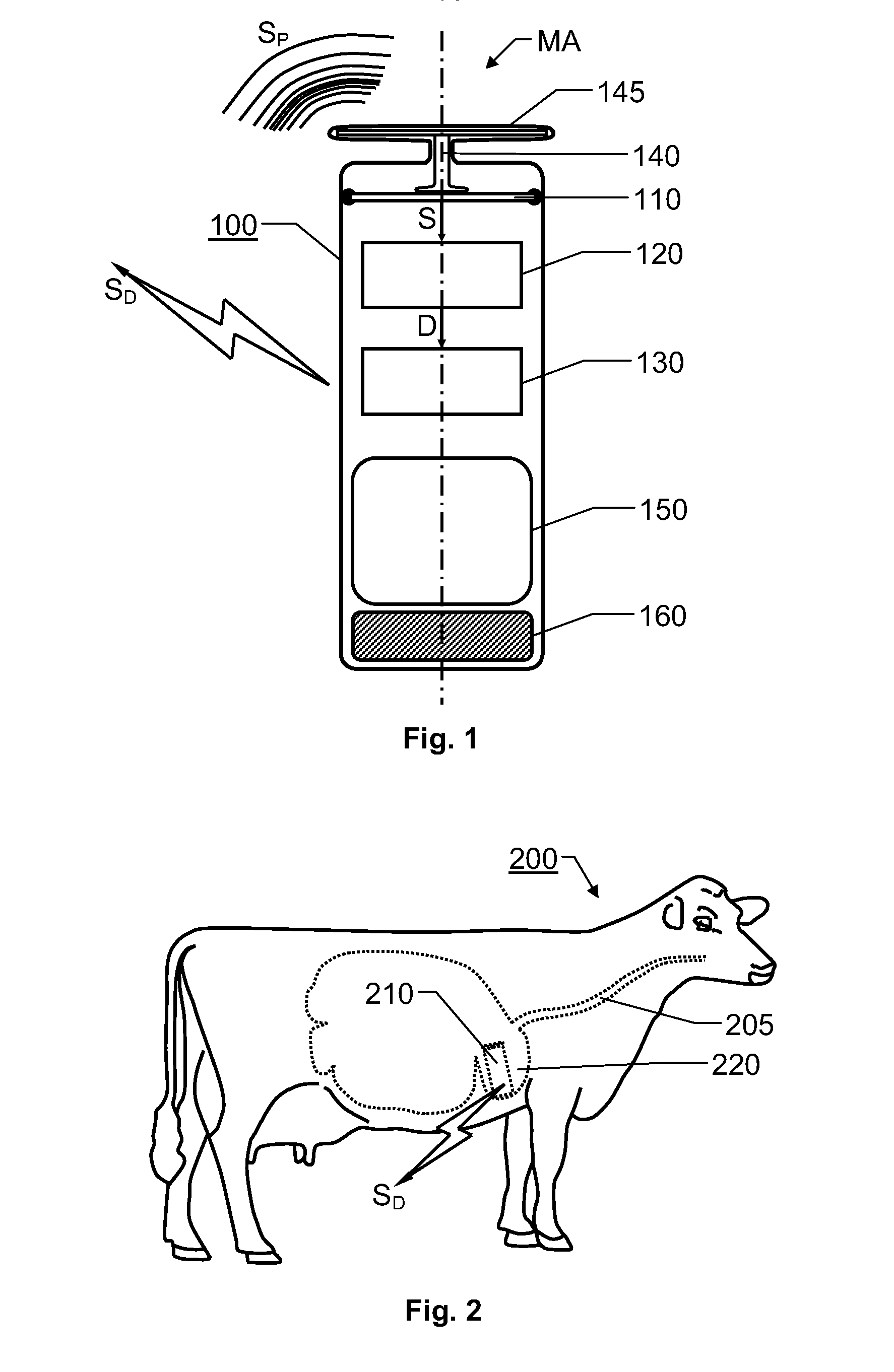Bolus
a ruminant animal and physiological monitoring technology, applied in the field ofbolus, can solve the problems of low sensor sensitivity and insufficient basis for determining the health condition of the animal
- Summary
- Abstract
- Description
- Claims
- Application Information
AI Technical Summary
Benefits of technology
Problems solved by technology
Method used
Image
Examples
first embodiment
[0031]FIG. 3a shows a sensor module 110 according to the invention, wherein the sensor module 110 includes a piezoelectric sensor 111, e.g. disc shaped. As can be seen in FIG. 3a, the guide means 140 is operatively connected to the sensor 111, such that any forces exerted on the mechanical amplifier element MA can be transported to the sensor 111. A support plate 112 (preferably of metal) is arranged on the opposite side of the sensor 111 to enable deformation of the sensor 111 in response to any forces applied via the guide means 140. To limit a maximum possible force exerted on the sensor 111 the sensor 111 is preferably connected to the case unit 100 via resilient members 113, e.g. of silicon. Alternatively, the sensor 111 may be held in the interior of the case unit 100 between a fixed support structure and a wave-shaped washer, which is configured to flex in response to a predefined force. Hence, any excessive external forces exerted on the sensor 111 can be absorbed by the wav...
second embodiment
[0033]FIG. 3b shows a sensor module 110 according to the invention, wherein the sensor module 110 includes a capacitive sensor. Here, a first metal plate 114 is arranged over a second metal plate 115, and a dielectric material (e.g. air) separates the first metal plate 114 from the second metal plate 115. A detector circuit 117 is used for measuring a capacitance between the first and second metal plates 114 and 115. The detector circuit 117 may either be connected to the second metal plate 115 and a guard ring 115a arranged concentrically around the sensor metal plate 115 (as shown in FIG. 3b), or the detector circuit 117 may be connected to both the first and second metal plates 114 and 115. In any case, analogous to the above, movements of the first metal plate 114 causes variations in the capacitance, which in turn may reflect heart activities, activities of the respiratory organs and / or stomach activities.
[0034]More precisely, for a constant distance between the metal plates 11...
third embodiment
[0037]FIG. 3c shows a sensor module 110 according to the invention, wherein the sensor module 110 includes a MEMS accelerometer configured to register acceleration and deceleration parameters. This type of component is advantageous because it can be designed as a so-called 3-axis sensor capable of registering deformations in three dimensions x, y and z (i.e. downwards / upwards as well as lateral movements in a plane). A 3-axis MEMS accelerometer detects acceleration and deceleration in three independent directions. Since gravitation constitutes one important example of acceleration (namely towards earth), the sensor can detect how it is oriented relative to earth with respect to each of said axes. Consequently, in addition to the above-mentioned pressure variations, the sensor may also determine static pressures. Additionally, extremely slow pressure variations can be registered accurately.
PUM
 Login to View More
Login to View More Abstract
Description
Claims
Application Information
 Login to View More
Login to View More - R&D
- Intellectual Property
- Life Sciences
- Materials
- Tech Scout
- Unparalleled Data Quality
- Higher Quality Content
- 60% Fewer Hallucinations
Browse by: Latest US Patents, China's latest patents, Technical Efficacy Thesaurus, Application Domain, Technology Topic, Popular Technical Reports.
© 2025 PatSnap. All rights reserved.Legal|Privacy policy|Modern Slavery Act Transparency Statement|Sitemap|About US| Contact US: help@patsnap.com



